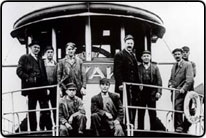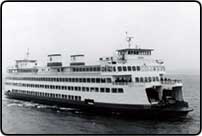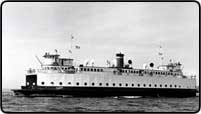History
Early Ferry Service
Washington State Ferries came into existence with the state’s buyout
of Puget Sound Navigation in 1951. Ferry service around Puget Sound has
changed tremendously over the course of the last century.
Originating in the early 1900s, Puget Sound ferry
service was initially provided by a number of companies using small
steamers known as the “Mosquito Fleet.” By 1929, the ferry industry
had consolidated into two companies: Puget Sound Navigation Company and
Kitsap County Transportation Company. A strike in 1935 forced Kitsap
County Transportation Company out of business and left the Puget Sound
Navigation Company, commonly known as Black Ball line, with primary
control of ferry service on Puget Sound.
After World War II, increasing labor costs made
private operation of the ferry system increasingly challenging. In the
late 1940s, ferry workers’ labor unions succeeded in securing higher
wages from the Puget Sound Navigation Company. The ferry service
provider petitioned the State Highway Department to allow a 30% fare
increase to meet new operating costs. When the State refused its
request, the Puget Sound Navigation Company tied up its boats, bringing
much of cross-sound ferry service to a halt.
Creation of WSF
 Washington State recognized that the ferries were a life line for many
communities and there was a need for reliable ferry service to meet
growing demand. In 1951, after numerous discussions with the State
Legislature over fares and service, the Puget Sound Navigation Company
sold all of its terminal facilities and ferries (with the exception of
the Seattle/Port Angeles/Victoria, B.C. route) for $5 Million to a newly
created Washington Toll Bridge Authority, now known as Washington State
Ferries (WSF).
Washington State recognized that the ferries were a life line for many
communities and there was a need for reliable ferry service to meet
growing demand. In 1951, after numerous discussions with the State
Legislature over fares and service, the Puget Sound Navigation Company
sold all of its terminal facilities and ferries (with the exception of
the Seattle/Port Angeles/Victoria, B.C. route) for $5 Million to a newly
created Washington Toll Bridge Authority, now known as Washington State
Ferries (WSF).
The ferry system was originally intended to provide
temporary service until a network of bridges could be built connecting
the west and east sides of Puget Sound. In 1959, however, the
legislature rejected the plan to build numerous cross sound bridges. At
that time, the responsibility for managing the ferry system was shared
by the Toll Bridge Authority and the State Highway Commission.
The Toll Bridge Authority set fares and controlled the
system’s finance, including long-term indebtedness, while the
operation of the ferry system was controlled by the Highway Commission.
In 1977, the two agencies were combined under the existing Washington
State Department of Transportation (WSDOT).
Development of the Fleet
 In its first year of service, the State operated ferry system carried
approximately four million passengers. The boats the State purchased
from the Puget Sound Navigation Company included a number of steel
diesel-electrics from San Francisco, the Illahee, Klickitat, Nisqually,
Quinault, Enetai, and Willapa; wooden diesel-electrics including the
Chetzemoka, Kehloken, and Klahanie; steamers such as San Mateo and
Shasta; wooden diesel-powered boats built in the Northwest such as the
Rosario, Kitsap, Crosline, Leschi, Skansonia and Vashon; and a former
great Lakes steamer, the Chippewa.
In its first year of service, the State operated ferry system carried
approximately four million passengers. The boats the State purchased
from the Puget Sound Navigation Company included a number of steel
diesel-electrics from San Francisco, the Illahee, Klickitat, Nisqually,
Quinault, Enetai, and Willapa; wooden diesel-electrics including the
Chetzemoka, Kehloken, and Klahanie; steamers such as San Mateo and
Shasta; wooden diesel-powered boats built in the Northwest such as the
Rosario, Kitsap, Crosline, Leschi, Skansonia and Vashon; and a former
great Lakes steamer, the Chippewa.
The new ferry system’s first challenge was to add
boats to meet growing demands for service, relieving backups that had
started occurring at terminals. Two ferries were purchased from
Maryland’s Chesapeake Bay, the Rhododendron and the Olympic. In 1953,
the State commissioned the Puget Sound Dredge and Bridge Company
(subsequently Lockheed) to build the first Evergreen State-class vessel,
which could carry 100 vehicles and 1000 passengers. Over the next 13
years, the ferry system responded to growing demand by rebuilding and
expanding the existing fleet. However, the Evergreen State-class ferries
could not keep pace with the demand. The Super-class ferries Hyak,
Kaleetan, Yakima and Elwha were built in 1967, each able to carry 160
cars and 2500 passengers. Within several years even the Super-class
ferries were unable to handle the demands of the system. To meet this
need, the Jumbo-class Spokane and Walla Walla ferries were built in 1973
with a capacity of 2000 passengers and 206 vehicles. The Issaquah-class
Issaquah, Kittitas, Chelan, Kitsap, Cathlamet and Sealth ferries were
added in the early 1980s to improve operations and replace aging boats.
These ferries each carry 1200 passengers and 100 cars (five have since
been modified to carry 130 cars).
 The fleet expanded during the 1997/99 biennium with the arrival of the
Jumbo Mark II-class vessels, Tacoma, Puyallup and Wenatchee. These
vessels, built by Todd Shipyards in Seattle came into active service in
the 97/99 biennium. Each vessel carries 2500 passengers and 212
vehicles. Construction of a new high-speed passenger-only class ferry,
the Chinook, was also completed this biennium. The Snohomish, the
Chinook's sister ship, was received in the 1999/01 biennium.
The fleet expanded during the 1997/99 biennium with the arrival of the
Jumbo Mark II-class vessels, Tacoma, Puyallup and Wenatchee. These
vessels, built by Todd Shipyards in Seattle came into active service in
the 97/99 biennium. Each vessel carries 2500 passengers and 212
vehicles. Construction of a new high-speed passenger-only class ferry,
the Chinook, was also completed this biennium. The Snohomish, the
Chinook's sister ship, was received in the 1999/01 biennium.
Financial History
When the ferry system was first purchased by the State from the Puget
Sound Navigation Company, it was intended to finance itself solely
through the fare box (revenues). The original bonds issued by the Toll
Bridge Authority in 1951 required that the system generate net revenues.
The ferry routes sustained revenues in excess of operating expenses
until 1960. The entire ferry/bridge system generated net revenue until
1974 because of the financial success of the Hood Canal toll bridge.
Tax support of the ferry system began in 1957 when the
State Legislature brought ferry system employees into the State
Retirement System. In 1959, the State Legislature created an account,
funded by 0.25 cents per gallon of the State’s gasoline sales tax, to
help pay debt service on revenue bonds issues by the Toll Bridge
Authority if costs exceeded revenues. In 1960, the ferry system failed
to meet the annual debt service requirements, and the ferry system
received $672,000 from the State’s motor vehicle fuel tax to cover the
bond payments. Additional ferry system/Hood Canal Bridge bonds were
issues in 1963. However, since the early 1970s, all of the debt service
payments for the ferry system bonds have come from motor vehicle fuel
taxes, not from ferry system operating revenues.
Over time, Washington State has continued to provide
tax support for ferry system operating and capital costs as a supplement
to WSF-generated revenues from fares and other miscellaneous income.
Since the 1970s, State tax sources have included a gasoline sales tax,
motor vehicle registration fees. Additionally, WSF pursues federal and
local funds for specific projects. The use of public funds for ferry
system purposes is strictly regulated, and taxes imposed for operating
and capital expenses are levied and tracked separately. The taxes used
to fund operating and capital expenses have been raised over the years
in order to cover growing operating and capital costs. In fiscal years
1998 and 1999, the ferry system generated revenue to cover 65% and 66%
of its operating costs, respectively. The Washington State
Transportation Commission mandates that the ferry system fare box
generate a minimum of 60% of the system’s operating expenses. The
remaining percentage is provided by tax support from the State.
WSF has been involved in the on-going assessment of
fares since 1991. Fare changes during the 1997/99 biennium have included
across-the-board fare increases of 2.3% and 2.2% in FY 1998 and FY 1999,
respectively, to adjust for inflation and several fare policy changes
such as fare rounding, revised commuter discounts, and a revision to the
peak season vehicle/driver surcharge.
WSF Today
WSF is the largest ferry system in the United States, serving eight
counties within Washington and the Province of British Columbia in
Canada. Counties served include Pierce, King, Snohomish, Kitsap, Skagit,
Island, San Juan, and Jefferson Counties. WSF’s existing system has 10
routes and 20 terminals that are served by 28 vessels. In fiscal year
1999, WSF carried over 11 million vehicles and 26 million people—over
one million more walk-on and vehicle passengers and 500,000 more
vehicles and drivers than in fiscal year 1997.





